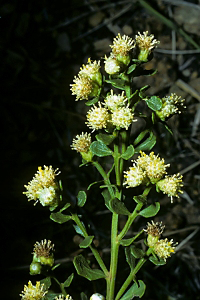|
Do you see...?
|
| Leaves
|
Young leaves
One or more young, unfolded leaves are visible on the plant. A leaf is considered "young" and "unfolded" once its entire length has emerged from a breaking bud, stem node or growing stem tip, so that the leaf base is visible at its point of attachment to the leaf stalk (petiole) or stem, but before the leaf has reached full size or turned the darker green color or tougher texture of mature leaves on the plant. Do not include fully dried or dead leaves.
How many young leaves are present?
- Less than 3
- 3 to 10
- 11 to 100
- 101 to 1,000
- 1,001 to 10,000
- More than 10,000
|
| Flowers
|
Flowers or flower buds
One or more fresh open or unopened flowers or flower buds are visible on the plant. Include flower buds or inflorescences that are swelling or expanding, but do not include those that are tightly closed and not actively growing (dormant). Also do not include wilted or dried flowers.
More...
How many flowers and flower buds are present? For species in which individual flowers are clustered in flower heads, spikes or catkins (inflorescences), simply estimate the number of flower heads, spikes or catkins and not the number of individual flowers.
- Less than 3
- 3 to 10
- 11 to 100
- 101 to 1,000
- 1,001 to 10,000
- More than 10,000
|
|
|
Open flowers
One or more open, fresh flowers are visible on the plant. Flowers are considered "open" when the reproductive parts (male stamens or female pistils) are visible between or within unfolded or open flower parts (petals, floral tubes or sepals). Do not include wilted or dried flowers.
More...
What percentage of all fresh flowers (buds plus unopened plus open) on the plant are open? For species in which individual flowers are clustered in flower heads, spikes or catkins (inflorescences), estimate the percentage of all individual flowers that are open.
- Less than 5%
- 5-24%
- 25-49%
- 50-74%
- 75-94%
- 95% or more
|
|
|
Pollen release
One or more flowers on the plant release visible pollen grains when gently shaken or blown into your palm or onto a dark surface.
More...
How much pollen is released?
- Little: Only a few grains are released.
- Some: Many grains are released.
- Lots: A layer of pollen covers your palm, or a cloud of pollen can be seen in the air when the wind blows
|
| Fruits
|
Fruits
One or more fruits are visible on the plant. For Baccharis pilularis, the fruit is very tiny and seed-like and is crowded into a small spent flower head. The seed-like fruit has a tuft of white hairs and changes from yellow-green to tan or light brown, and drops or is blown from the plant. Do not include empty flower heads that have already dropped all of their fruits.
More...
How many fruits are present?
- Less than 3
- 3 to 10
- 11 to 100
- 101 to 1,000
- 1,001 to 10,000
- More than 10,000
|
|
|
Ripe fruits
One or more ripe fruits are visible on the plant. For Baccharis pilularis, a fruit is considered ripe when it has turned tan or light brown, or when it readily drops or is blown from the spent flower head when touched. Do not include empty flower heads that have already dropped all of their fruits.
More...
What percentage of all fruits (unripe plus ripe) on the plant are ripe?
- Less than 5%
- 5-24%
- 25-49%
- 50-74%
- 75-94%
- 95% or more
|
|
|
Recent fruit or seed drop
One or more mature fruits or seeds have dropped or been removed from the plant since your last visit. Do not include obviously immature fruits that have dropped before ripening, such as in a heavy rain or wind, or empty fruits that had long ago dropped all of their seeds but remained on the plant.
More...
How many mature fruits have dropped seeds or have completely dropped or been removed from the plant since your last visit?
- Less than 3
- 3 to 10
- 11 to 100
- 101 to 1,000
- 1,001 to 10,000
- More than 10,000
|
